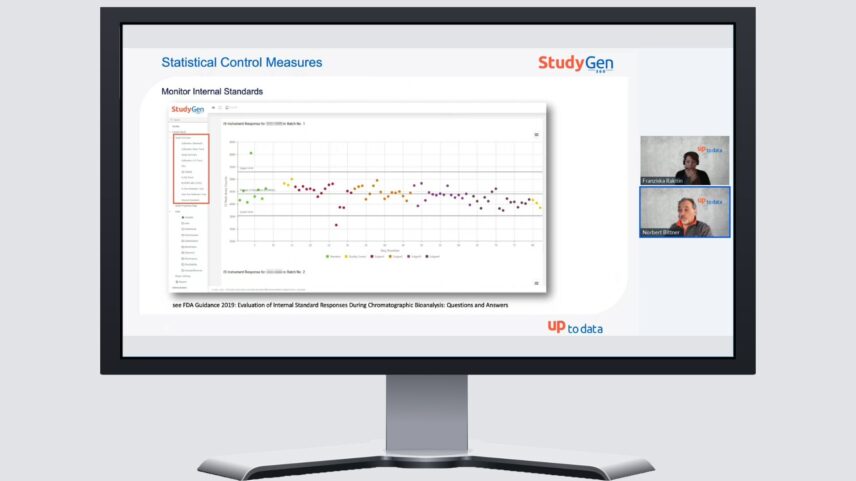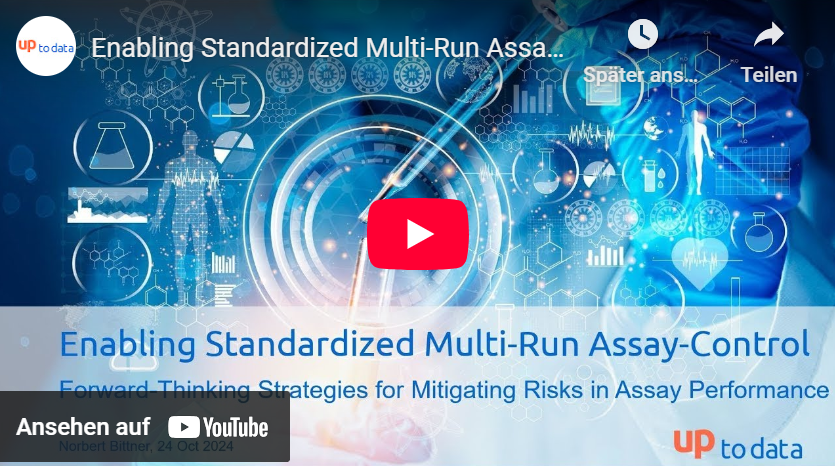knowledgeEnabling Standardized Multi-Run Assay Control: Key Insights for Bioanalytical Labs
 Bioanalytics
Data Integrity
Reporting
Bioanalytics
Data Integrity
Reporting

In an increasingly complex regulatory environment, bioanalytical laboratories face growing challenges in maintaining consistent assay performance across long-running studies. A recent webinar led by Norbert Bittner, CEO of up to data, provided comprehensive insights into implementing standardized multi-run assay–controls and highlighted effective strategies for risk mitigation in bioanalytical testing.
Understanding the Stakes: Why Assay Control Matters
The integrity of bioanalytical data forms the cornerstone of drug development and research validity. As studies become more complex, the risks associated with conducting multiple assay runs increase significantly. When assay performance varies or degrades over time, the consequences can cascade throughout the entire research process, potentially compromising study outcomes and regulatory compliance.
Modern laboratories must contend with multiple challenges that can compromise data quality and consistency. The risks associated with inadequate assay control are significant and multifaceted:
- Data Integrity Risks: Inconsistent assay performance can lead to questionable data quality and reliability, potentially invalidating entire studies.
- Regulatory Compliance Issues: Non-compliance with GxP requirements and regulatory standards can result in rejected submissions and regulatory actions.
- Study Failure Risk: Performance fluctuations can cause data to fail required standards, leading to study delays or rejections.
- Operational Challenges: Poor assay control often leads to repeated analyses, wasted resources, and increased operational costs.
- Reputational Impact: For CROs, inconsistent results can damage client relationships and market standing.
- Financial Consequences: Both direct costs from failed studies and indirect costs from lost business opportunities can significantly impact on the bottom line.
Video Recording
Get comprehensive insights into implementing standardized multi-run assay-controls and highlighted effective strategies for risk mitigation in bioanalytical testing.

Future Digital Transformation of Assay–Control
While laboratory processes have become increasingly digital, current laboratory information management systems (LIMS) primarily focus on data storage and basic batch-level quality control. Most device software provides single-batch QC checks but lacks capabilities for cross-batch analysis or advanced trend detection. Traditional LIMS typically don’t integrate these QC checks directly and often lack access to the detailed data needed for comprehensive quality control analysis.
To address these limitations, modern solutions are emerging that bridge this gap. Our system specifically focuses on two key areas: automating the generation of regulatory reports from device data and enabling sophisticated in-study data analysis. Rather than relying on hypothetical AI-driven predictive maintenance, we’ve implemented a practical approach using Large Language Models (LLMs) that transforms how scientists interact with their data. Scientists can describe their analytical needs in natural language, and our system translates these requests into reproducible, validated analyses of the stored study data. This approach maintains scientific rigor while making complex data analysis more accessible to laboratory personnel.
This solution represents a realistic step forward in laboratory data management – one that addresses actual pain points in regulatory compliance and data analysis rather than promising futuristic AI capabilities that aren’t yet feasible in typical laboratory settings.
Building a Robust Assay Control Framework
A comprehensive approach to assay control begins with understanding that quality isn’t just about meeting minimum standards – it’s about building systems that consistently deliver reliable results. The foundation of this approach lies in standardization, combined with modern technology and rigorous processes.
While Standard Operating Procedures (SOPs) provide the backbone of laboratory operations, effective assay control requires a more nuanced approach. Modern laboratories should develop detailed workflows that account for various scenarios and potential problems. This includes comprehensive protocols for sample handling and storage, clear guidelines for instrument maintenance and calibration, and well-defined procedures for data review and approval. Regular training programs ensure that laboratory personnel maintain consistently high standards, while systematic documentation processes support regulatory compliance.
Statistical Control Measures: The Power of Data-Driven Insights
Modern assay control relies heavily on statistical measures to identify and prevent problems before they affect study outcomes. Calibration curve performance tracking provides crucial insights into method sensitivity and stability, with regular monitoring of parameters such as LLOQ response trends and signal-to-noise ratios revealing early warning signs of potential issues.
Retention time consistency monitoring represents another crucial aspect of assay control. Variations in retention times can indicate problems with chromatographic conditions, column performance, or sample preparation. By implementing systematic monitoring of these parameters, laboratories can identify and address issues before they impact study results.
The role of internal standard response monitoring has gained increased attention, particularly following the FDA’s 2019 guidance on chromatographic bioanalysis. This parameter provides crucial information about sample preparation consistency and instrument performance stability.
Implementation and Outlook
The implementation of standardized multi-run assay controls requires a systematic approach that begins with careful assessment of current practices and identification of areas for improvement. This leads to the development of a comprehensive implementation strategy, followed by technology integration and thorough staff training. Continuous monitoring and adjustment of processes ensure ongoing effectiveness and improvement.
The future of bioanalytical assay control lies in thoughtful integration of practical technological solutions. Modern cloud-based systems are improving collaboration between sponsors and CROs by streamlining data sharing and standardizing reporting processes. The innovative use of language models to translate scientific requirements into validated analytical workflows represents a significant step forward in making complex data analysis more accessible while maintaining rigorous quality standards.
Our approach demonstrates how modern technology can enhance laboratory operations in tangible ways – automating regulatory reporting, enabling reproducible analysis workflows, and providing scientists with powerful yet intuitive tools for data exploration. This practical application of advanced technology, combined with strong fundamental quality practices, helps laboratories maintain consistency and efficiency across multiple assay runs.
Laboratories that focus on implementing these proven solutions – rather than waiting for hypothetical future capabilities – are better positioned to meet current market demands. The combination of standardized processes, validated analytical workflows, and strategic automation creates a robust framework for delivering reliable results while improving operational efficiency. This pragmatic approach to technological advancement ensures that innovations serve the real needs of laboratory scientists while maintaining the highest standards of data quality and regulatory compliance.
This article is based on insights from a webinar presented by Norbert Bittner, CEO of up to data. He is an expert in providing automated reporting solutions for regulated environments. The company specializes in implementing digitized and automated laboratory processes for regulatory study data management.
